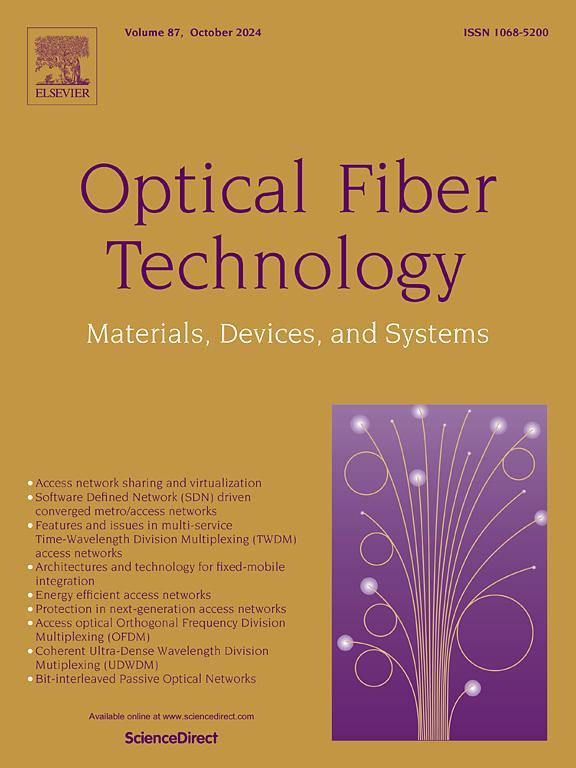Sub-millisecond response fiber-optic temperature sensor based on microfabricated silicon Fabry-Pérot interferometer
IF 2.7
3区 计算机科学
Q2 ENGINEERING, ELECTRICAL & ELECTRONIC
引用次数: 0
Abstract
This study proposes a novel fiber-optic temperature sensor based on a microfabricated short-cavity silicon Fabry-Pérot interferometer (FPI), achieving miniaturized sensing unit and sub-millisecond response. The sensor employs micro-electromechanical systems (MEMS) technology and fiber-waveguide coupling technology to fabricate a 17-μm-length and 125-μm-diameter silicon-based FPI on the fiber tip. By significantly reducing the cavity length of the FPI, the free spectral range (FSR) is markedly expanded, enabling temperature demodulation through intensity measurement while maintaining a broad monotonic measurement range. Experimental results show that the sensor has an FSR of 19.8 nm near 1550 nm with 20.0 dB modulation depth. The sensor exhibits monotonicity within a temperature range of 98 ℃ near normal temperature. For establishing the functional relationship between the reflectivity of the sensing head and the ambient temperature, the test data of temperature induced reflectivity variation of the sensor from −5 ℃ to 63 ℃, is fitted by a third-order polynomial. The agreement between the fitting results and experimental data demonstrates that the sensor can be calibrated for measurement within a temperature range of 68 ℃. The temperature stability of the fiber-optic sensor is 0.076 ℃, which means the resolution is better than 0.1 ℃. We also estimate that the average sensitivity of the sensor is approximately 66 mV/℃ under reasonable conditions. Immersion testing by dipping the sensing head quickly into hot water reveals a 0.54 ms response time, which is consistent with theoretical calculations. The standardized fabrication process of the sensor satisfies industrial production requirements. The developed compact, fast-responding fiber-optic temperature sensor demonstrates strong potential for oceanographic temperature monitoring.
基于微晶硅法布里-波干涉仪的亚毫秒响应光纤温度传感器
本研究提出了一种基于微加工短腔硅法布里-帕氏干涉仪(FPI)的新型光纤温度传感器,实现了传感单元的小型化和亚毫秒级响应。该传感器采用微机电系统(MEMS)技术和光纤波导耦合技术,在光纤尖端制作了长度为17 μm、直径为125 μm的硅基FPI。通过显著减小FPI的腔长,自由光谱范围(FSR)得到显著扩展,从而可以通过强度测量实现温度解调,同时保持较宽的单调测量范围。实验结果表明,该传感器在1550 nm附近的FSR为19.8 nm,调制深度为20.0 dB。该传感器在接近常温的98℃温度范围内呈现单调性。为了建立传感头反射率与环境温度的函数关系,对传感器在−5℃~ 63℃温度诱导反射率变化的测试数据进行了三阶多项式拟合。拟合结果与实验数据吻合,表明该传感器可在68℃的温度范围内进行标定。光纤传感器的温度稳定性为0.076℃,即分辨率优于0.1℃。我们还估计在合理条件下传感器的平均灵敏度约为66 mV/℃。通过将传感头快速浸入热水中进行浸泡测试,响应时间为0.54 ms,与理论计算一致。传感器的标准化制造工艺满足工业生产要求。开发的紧凑、快速响应的光纤温度传感器在海洋温度监测中显示出强大的潜力。
本文章由计算机程序翻译,如有差异,请以英文原文为准。
求助全文
约1分钟内获得全文
求助全文
来源期刊

Optical Fiber Technology
工程技术-电信学
CiteScore
4.80
自引率
11.10%
发文量
327
审稿时长
63 days
期刊介绍:
Innovations in optical fiber technology are revolutionizing world communications. Newly developed fiber amplifiers allow for direct transmission of high-speed signals over transcontinental distances without the need for electronic regeneration. Optical fibers find new applications in data processing. The impact of fiber materials, devices, and systems on communications in the coming decades will create an abundance of primary literature and the need for up-to-date reviews.
Optical Fiber Technology: Materials, Devices, and Systems is a new cutting-edge journal designed to fill a need in this rapidly evolving field for speedy publication of regular length papers. Both theoretical and experimental papers on fiber materials, devices, and system performance evaluation and measurements are eligible, with emphasis on practical applications.
 求助内容:
求助内容: 应助结果提醒方式:
应助结果提醒方式:


